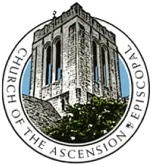Numbers 21:4-9; Psalm 107:1-3, 17-22; Ephesians 2:1-10; John 3:14-21
The Rev. Drew Brislin
In the name of the one Holy and Undivided Trinity, Amen.
As we continue on our Lenten journey, we find ourselves at the midway point, the intermission if you will. It seems so often it is just about this point in a trip that children begin to ask their parents from the backseat how much longer. If I were running a marathon, I’m sure the midway point is where would start to wonder ‘Why am I doing this?’ Starting things can be fun. It’s new and exciting but somewhere along the way the newness and the allure of whatever drew you into the adventure begins to wear off. Monotony sets in and excitement turns to dread. About this time last year, I noticed that something was not quite right with my body. I began to get winded very easily and discovered that exercising was almost impossible. I went to my doctor who prescribed some medication to help in the moment and he sent me to a cardiologist to take a deeper dive and make sure there were no serious underlying problems. I wanted to be better and so I was nervously excited about getting help. However, as one procedure led to another then to another, finally culminating in a heart catheterization, I began to wonder how far this journey was going to take me before I knew what or if anything was majorly wrong. We can apply this methodology to different aspects of our lives.
Our collect this morning seems to point us towards shift in Lent from recognizing where we have gone astray, from acknowledging our weakness to looking towards Jesus as the ‘True Bread’ that gives life. Our collect this morning replaced one that beseeched relief from deserved punishment which seems rather ominous. This more hopeful and promising collect seems to reflect the themes of healing and grace that we encounter in our lectionary readings. Our Gospel reading this morning is the continuation of the conversation between Jesus and Nicodemus. It begins by making a reference to the story we hear in our Old Testament reading from Numbers about the bronze serpent that God told Moses to make and put on a pole so that the people of Israel could look to it and be healed. The very thing that was causing harm to the people of Israel is the thing that God works through to bring healing. Jesus tells Nicodemus that just as Moses lifted the bronze snakes up to heal, he must be lifted up so that God may again heal the world. Then we hear what may be the most well know verse in the Bible, “For God so love the world that he gave his only Son, so that everyone who believes in him may not perish but may have eternal life. How many times have we seen this scripture on bumper stickers, on banners flown by airplanes or on football player’s eye black. It is a very hopeful and encouraging verse that has also been misused to give some authorization to judge others and draw division between believers and non-believers. So many people stop at verse 16 and do not continue on to read “Indeed, God did not send the Son into the world to condemn the world, but in order that the world might be saved through him.” Judgement comes but what we seem to miss or what some want to omit is that Jesus’ judgement is always made with grace. God created man and woman and said they were very good. Just as the collects gather the prayers of the people so to does Jesus collect us into himself. This true bread that gives life to the world draws us into community with each other so that we might more fully be in relationship with the Father through the Son. As we continue to grow our understanding of our relationships with technology and information we seek to know and grow our relationships with each other and with God.
If you have been following along with our Lenten disciplines as we have been trying to understand how we absorb information, much of what we have been doing, I think, are self-examinations of our relationships with technology and information. We have been reflecting on what sources of technology we use, why we use them and then trying to moderate our engagement with our screens or other tools of technology. Now at this midpoint in our journey we will begin to look at ways to improve our relationships with those tools. Can we find better sources or find ways to better engage our hearts and minds so that we might better engage one another. We have learned over the last few years that technology is a marvelous tool for connecting us to each other. Allowing people who could not be with us in person a means to find a new connection to worship. Just as the snake which was a source of harm became a source for healing so too can technology and information become sources for building community and growth. What becomes important I think is our relationships with these tools and with each other. I look forward to seeing the good fruit that will be harvested over the next few weeks as we continue to discern these questions and our paths together as we search for clearer understandings of our relationships with each other and as the Body of Christ.
Amen
